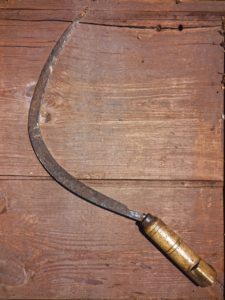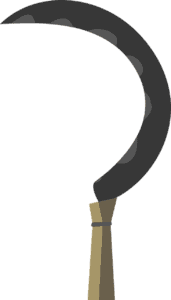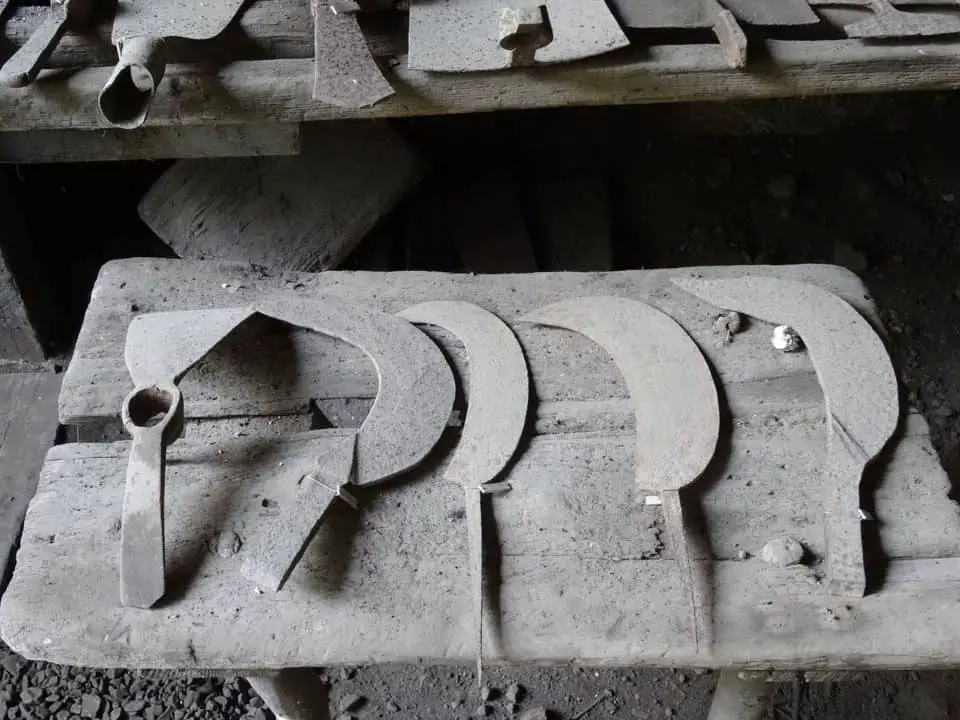Some links in the post are affiliate links and I get a commission from purchases made through some links found in the post.
With organic gardening picking up pace and more people frowning upon commercialized forms of gardening, the sickle has once again become a tool of interest.
This tool has been around for millennia, and its use dates to thousands of years ago. Even back in the Neolithic period, the sickle was still a trusted implement.
As gardeners harvested wheat, barley, and other grasses, they knew that this small tool had their back. We will look at why it was a good choice then and why you can consider adding it to your gardening routine.
Can a Sickle be Used for Weeding?
 Let us start with the main point- weeding. Not all weeding tools are the same. Instead, they fall into different categories based on their working mechanism.
Let us start with the main point- weeding. Not all weeding tools are the same. Instead, they fall into different categories based on their working mechanism.
For example, digging tools work under the surface to scoop up weeds by the roots. Such tools work great on taproots because they get to deeper soil sections.
Raking tools work by loosening the soil surface and getting rid of weeds on the soil surface. Some hoes can do this job, but more often, people use cultivators which work on fibrous and shallow runner roots.
Sickles, on the other hand, are cutting tools, as are asparagus knives and hori-hori knives.
As the name suggests, they work by cutting the weeds and are best for running and fibrous roots. You hold the tools by hand and cut down the foliage.
You also can get upright tools such as shovels and stirrup hoes that feature more digging than cutting. With sickles, it becomes easier to work around plants you would like to protect.
For example, if you have a plant in between the weeds, using a strimmer would not be a good idea. However, using a sickle enables you to remove everything but the protected plant.
So, can you use a sickle hoe for weeding? Yes and no. For fibrous roots and plants with runners, a sickle can serve you well.
But if you are working with long taproots, using a sickle would hardly give you satisfactory results. The weeds would be back in no time.
You may also like: What is a cutter mattock
What is a Garden Sickle?
The garden sickle goes by many names, including bagging hook, grass hook, and reaping hook. It is a one-handed tool with a curved blade that works for various uses.
Farmers use it for reaping grain crops and cutting foliage, with its uses having increased over the years. The build of the sickle has also changed over time.
Initially, sickles featured iron blades. Now, it is common to come across sickles with steel blades with either serrated or smooth edges.
Serrated edges are more common in reaping grains, while smooth blades work best for cutting green grass or grown cereals.
How People use Sickles
We will start with the build of the sickle. Its blade curves towards the inside, with its sharp edge facing away from the outer curve.
As you draw it towards you, the blade cuts the crop and slices it at the contact point. Sickles are one-handed, and you can only use one hand to move them towards you.
The other hand can either grab on the crops being cut or stay out of the way.
Did you know? Sickles are also used as weapons in some parts of the world. For example, martial arts in Malaysia featured sickles.
These tools feature very sharp blades, and you must be careful when using them, lest you get injured.
You may also like: Action hoe vs garden hoe
Why Should you use a Sickle?
When it comes to efficiency, it is easy to lean on machine-operated weeding or harvesting tools instead of a sickle. They are fast and can cover large areas in no time.
However, once you bring in the aspect of conservation, they fall short. Machines are indiscriminate and will cut everything in their way.
Thus, if you have some shrubs or plants you would like to preserve, the only way to do this is by using an organic weeding or harvesting method, in this case, the sickle works wonders.
First, a sickle is easy to use. Plus, it enables you to get some exercise in as you work around the plants. What an excellent way to save money on gym fees and keep fit.
 Also, if you choose the right sickle for the job, you should not struggle. Keep the blade type and position in mind relative to the grass, weeds, or crops in the garden. You can also get an angled blade if you want to get a closer trim.
Also, if you choose the right sickle for the job, you should not struggle. Keep the blade type and position in mind relative to the grass, weeds, or crops in the garden. You can also get an angled blade if you want to get a closer trim.
Secondly, sickles are sharp, and with a few moves, you can cut down crops. It makes it easier to move through one section at a time, ensuring you do not miss a thing.
You can even sharpen them as you go to ensure you use minimal effort for a great job. Of course, their trim will not be perfect, but it will be good enough.
Using a sickle takes time to master. You also need to be patient as you learn how to hold the sickle for maximal efficiency and minimal strain. So, how do you work with a sickle without harming yourself?
Dressing
Long trousers, boots, and gloves should be your first line of defense when using the sickle. Until you get the hang of using the blade, and even after that, you should cover up for safety.
Sharpening the Blade
You should always sharpen the blade to reduce the effort used in cutting. Carborundum stones work magic in this case.
Using the Blade
You can use the blade with any hand and swing it in any direction. Please direct the movement away from the body to prevent any accidents.
The blade should always be away from your arms and legs. Smaller movements are always better than large movements as they give you more control over the swing.
Also, when cutting long grasses, use one hand to hold the grasses and another to cut the grass with the sickle. Always keep a reasonable distance between the holding hand and the cutting hand.
Storing the blade
Keep the blade away from pets and children when it is not in use. In addition, investing in a safety guard is always a good idea to prevent other people from accessing the sickle.
You may also like: What is the difference between pruners and secateurs
Can you Cut Grass with a Sickle?
Sure! One of the primary uses of the sickle is cutting grass. While you can use any sickle to cut grass, it helps to consider the location of the blade.
Those with standard blades are best used for grain crops as the harvesting takes place near the ground. Therefore, their blades are a bit raised.
However, sickles for harvesting grass have downward blades that are much closer to the ground. Thus, it makes it easier to cut the grass without leaving too much on the surface or straining your hand.
Additionally, consider the edges of the blade. Serrated edges are more common for grain crops. Green grass, on the other hand, is easy to cut with a smooth edge.
Cutting mature and thick grasses, however, may be easier with a serrated blade. Therefore, when choosing your sickle, consider its blade position and type and match this with the grass you want to cut.
Finally, you need to consider the length of the handle. Working with a long-handled sickle is always easier on your hands and back. Plus, it works great for small areas where you do not necessarily need to mow the grass.
What is the Difference Between a Sickle and a Scythe?
Sickles and scythes look similar, and sometimes, people reference them interchangeably. But are they the same? Not quite.
Scythes have long curved blades with long handles, while sickles fall on the shorter side. Additionally, scythes boast wider cutting widths.
Scythes date back centuries ago and are often used in mowing grass and grain crops. Moreover, they come in handy in cutting back other crops.
Generally, their blades, made of iron, measure anything from 12 to 50 inches. To give you a visual, scythes are pretty much what the grim reaper carries.
On the other hand, sickles are best used in reaping and cutting crops. Given their short blades and handles, users often must adopt a sitting position when using them. Thus, it takes more time to use them.
Let us differentiate these agricultural tools on each aspect:
- Blade size: The scythe features a longer blade size
- Blade shape: The scythe has a curved blade with an elongated tip, while the sickle features a hooked blade
- Handle length: The scythe has a longer handle
- Swing: The scythe only works from right-to-left, while the sickle works right-to-left and left-to-right
- Position: You must stand to use a scythe, whereas you must sit or squat to use a sickle
- Cutting: Scythes cannot cut forage, but sickles can
Final Thoughts: Can a Sickle Be Used For Weeding?
 Here is a tip when getting your sickle- go older. Modern tools, while also effective, tend to feature blades that are barely strong and quite hard to sharpen.
Here is a tip when getting your sickle- go older. Modern tools, while also effective, tend to feature blades that are barely strong and quite hard to sharpen.
They can frustrate you by coming apart within weeks of purchase. Instead, seek older tools that are easier to sharpen.
Plus, they will probably be much cheaper. If you cannot find older options, you can consider modern blades but watch out for any bad reviews.
Good luck weeding with your sickle, Happy Gardening!
Before you go, here are some more related articles I encourage you to read below to help solve more of your gardening issues:


